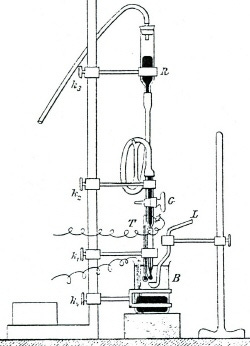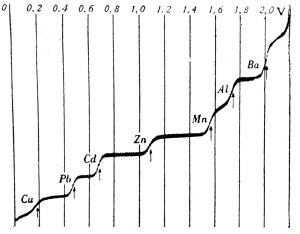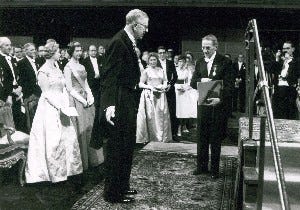If you find this work valuable, consider supporting it by becoming a paid subscriber. For just £3.50/month, you'll unlock full access to everything Electrochemical Insights has to offer.
Paid subscribers can reach out directly to me for guidance on their research, data analysis, and experimental design!
The 20th century saw chemistry transition from a theoretical discipline into a highly practical field, shaping industries, medicine, and environmental science. Among those who bridged fundamental research with real-world applications, Jaroslav Heyrovský stands out as a pioneer in electrochemical sensing. His development of polarography in 1922 laid the foundation for modern voltammetry, a method now used in applications as varied as medical diagnostics, industrial analysis, and environmental monitoring.
Heyrovský’s invention of the dropping mercury electrode (DME) provided an unparalleled level of reproducibility in electrochemical measurements, allowing researchers to quantify chemical species in solution with unprecedented sensitivity. This method became the basis for electrochemical biosensors, paving the way for technologies such as glucose sensors for diabetics, DNA hybridisation sensors, and point-of-care diagnostic devices.
His scientific journey was not without obstacles. He lived through two world wars, Nazi occupation, and the Soviet-imposed Iron Curtain, yet remained steadfast in his commitment to research. Over four decades, Heyrovský refined and expanded the field of polarography, ensuring its widespread adoption in chemistry and beyond.
A Life Shaped by Science: Early Years and Education
Born on 20th December 1890 in Prague, then part of the Austro-Hungarian Empire, Heyrovský was the fifth child of Leopold Heyrovský, a professor of Roman Law at Charles University. While his father was a legal scholar, Heyrovský gravitated towards the physical sciences from an early age.
In 1909, he enrolled at Charles University in Prague, where he studied mathematics, physics, and chemistry. During this time, he was particularly influenced by the physicists František Zāviška and Bohumil Kučera, as well as the chemist Bohumil Brauner, a former student of Sir Henry Roscoe and a renowned expert on the rare earth elements.
Rather than following the common Czech academic path to Germany, France, or Switzerland, Heyrovský made an unusual decision—he chose to study in England, enrolling at University College London (1910–1914). There, he studied under Sir William Ramsay and most importantly, Frederick G. Donnan, an expert in electrochemistry and membrane phenomena.
Heyrovský’s early research focused on the electrochemical properties of aluminium, a topic that would later lead him to develop his ground breaking technique. His first encounter with electrocapillarity—the foundation of polarography—likely came from his exposure to Lippmann’s studies on mercury surfaces and Kučera’s work on electrocapillary curves.
The Discovery of Polarography: A Game-Changer in Electrochemical Analysis
By 1922, while working at Charles University, Heyrovský had developed polarography, an electrochemical technique that allowed scientists to study oxidation and reduction reactions in solution with unprecedented precision.
At the heart of polarography was the dropping mercury electrode (DME). This consisted of a capillary tube that released mercury drops at a controlled rate, creating a continuously renewing electrode surface. This eliminated contamination issues seen with solid electrodes, making electrochemical measurements far more reproducible.
Heyrovský’s key insight was that as voltage was applied to the DME, different chemical species exhibited characteristic current responses. This allowed him to generate current-voltage curves (polarograms) that served as fingerprints for specific ions and molecules.
How Polarography Revolutionised Electrochemistry
Highly reproducible results: The self-renewing mercury surface eliminated contamination issues.
Selective detection of multiple species: Each analyte produced a unique half-wave potential, allowing for precise qualitative and quantitative analysis.
Exceptional sensitivity: Polarography enabled the detection of substances at nanomolar concentrations, making it an essential tool in analytical chemistry.
Heyrovský’s discovery was published in English in 1923, and within a decade, polarography had gained global recognition.
Polarography’s Global Impact: From Heavy Metals to Medicine
Polarography found widespread applications in various fields, including:
Environmental Chemistry – The technique became essential for detecting toxic metals such as lead, cadmium, and mercury in water.
Pharmaceutical Analysis – The method was used to characterise drugs, vitamins, and biochemical compounds.
Medical Diagnostics – Early applications included blood serum analysis and catalytic hydrogen currents for protein detection—precursors to modern biosensors.
By the 1930s, Heyrovský’s technique had become a standard method in laboratories worldwide. His advancements directly influenced modern biosensors, including:
Glucose sensors for diabetics
DNA-based electrochemical sensors
Point-of-care diagnostic devices
A Nobel Prize and International Recognition
Despite his ground breaking discoveries, Heyrovský had to wait decades for recognition. Between 1940 and 1959, he was nominated for the Nobel Prize in Chemistry 67 times—an indication of his global impact.
Finally, in 1959, he became the first Czech scientist to win the Nobel Prize in Chemistry, with the committee recognising his "discovery and development of the polarographic methods of analysis." His Nobel Lecture reaffirmed his belief that polarography was not merely an analytical tool but a fundamental contribution to electrochemistry.
A Legacy That Continues to Inspire
Beyond research, Heyrovský played a critical role in training the next generation of electrochemists. He established a school of Czech polarographers, many of whom went on to refine and expand his discoveries.
In 1950, he was appointed Director of the Polarographic Institute, which later became part of the Czechoslovak Academy of Sciences. Today, the institute bears his name: the J. Heyrovský Institute of Physical Chemistry.
His influence extended far beyond his home country. He lectured around the world, including in the United States (1933), the USSR (1934), England (1946), Sweden (1947), China (1958), and Egypt (1960–1961). His work remains one of the cornerstones of modern electrochemical sensing.
Final Thoughts: A True Pioneer of Electrochemical Analysis
Heyrovský’s discoveries transformed electrochemistry from a theoretical science into a precise analytical tool. Before him, electrochemical techniques were qualitative; after him, they became quantitative, reliable, and indispensable.
Today, biosensors, medical diagnostics, and environmental monitoring all stand on the shoulders of Heyrovský’s ground breaking discoveries. As researchers continue to refine electrochemical sensing, they do so in the footsteps of a scientist who transformed how we measure, detect, and understand the chemical world.
Thank you for supporting Electrochemical Insights!













